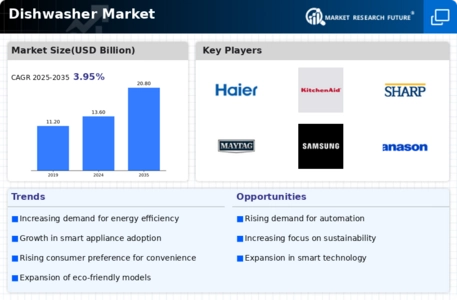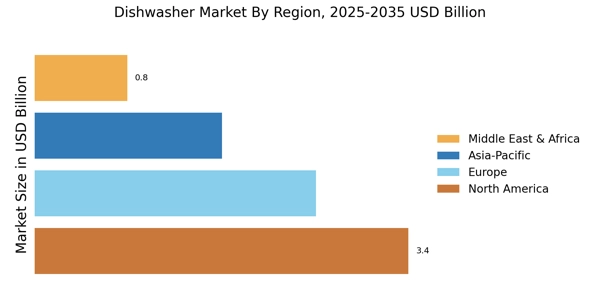The Dishwasher Market is currently characterized by a dynamic competitive landscape, driven by innovation, sustainability, and technological advancements. Major players such as Whirlpool (US), Bosch (DE), and LG Electronics (KR) are at the forefront, each adopting distinct strategies to enhance their market positioning. Whirlpool (US) emphasizes product innovation and energy efficiency, while Bosch (DE) focuses on premium quality and advanced features, appealing to environmentally conscious consumers. LG Electronics (KR) leverages its expertise in smart home technology, integrating AI capabilities into its dishwashers, thereby enhancing user experience and operational efficiency. Collectively, these strategies not only intensify competition but also push the industry towards higher standards of performance and sustainability.
In terms of business tactics, companies are increasingly localizing manufacturing to reduce costs and improve supply chain resilience. This approach appears to be particularly effective in mitigating disruptions and enhancing responsiveness to regional market demands. The competitive structure of the Dishwasher Market is moderately fragmented, with several key players holding substantial market shares. However, the influence of these major companies is significant, as they set trends and standards that smaller players often follow, thereby shaping the overall market dynamics.
In August 2025, Bosch (DE) announced the launch of its new line of dishwashers featuring advanced AI technology that optimizes water and energy usage based on load size and soil level. This strategic move not only reinforces Bosch's commitment to sustainability but also positions the company as a leader in smart appliance technology. By integrating AI, Bosch enhances user convenience while addressing growing consumer demand for eco-friendly products, thereby solidifying its competitive edge in the market.
In September 2025, LG Electronics (KR) unveiled a partnership with a leading tech firm to develop a new app that allows users to monitor and control their dishwashers remotely. This initiative reflects LG's focus on digital transformation and consumer engagement, catering to the increasing preference for smart home solutions. The app's features, which include maintenance alerts and energy usage tracking, are likely to enhance customer satisfaction and loyalty, further differentiating LG in a crowded marketplace.
In October 2025, Whirlpool (US) launched a new marketing campaign aimed at promoting its energy-efficient dishwashers, highlighting their reduced environmental impact. This campaign not only aligns with global sustainability trends but also positions Whirlpool as a responsible brand in the eyes of eco-conscious consumers. By emphasizing energy efficiency, Whirlpool seeks to attract a demographic that prioritizes sustainability, thereby enhancing its market share in an increasingly competitive environment.
As of October 2025, the Dishwasher Market is witnessing a pronounced shift towards digitalization, sustainability, and AI integration. These trends are reshaping competitive dynamics, with strategic alliances becoming increasingly common as companies seek to leverage complementary strengths. The focus appears to be shifting from price-based competition to differentiation through innovation, technology, and supply chain reliability. As the market evolves, companies that can effectively harness these trends are likely to emerge as leaders, setting new benchmarks for performance and consumer satisfaction.


















Leave a Comment